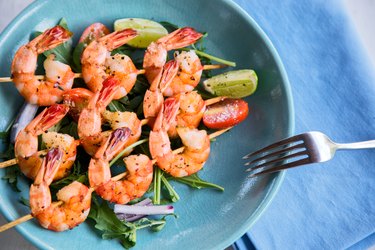
Precooked shrimp is a boon as it can be thrown into dishes with hardly any prep — think quick pastas, a simple sauté of precooked shrimp or easy-peasy frozen cooked shrimp appetizer recipes. Just follow a few rules to make sure your shrimp doesn't become dried out or rubbery and you're good to go.
It's great to know that precooked shrimp is waistline-friendly, at least before other ingredients are added. According to the U.S. Food and Drug Administration (USDA), a 3-ounce portion of cooked shrimp has only 84 calories, along with 20.4 grams of protein, no carbohydrate and barely any fat.
Video of the Day
Video of the Day
If you sauté precooked shrimp with oil, or otherwise add high-fat or carb ingredients, you will obviously bump up the calories somewhat, but the nutritional benefits remain. As well as plenty of protein, 3 ounces of cooked shrimp provides 1.39 milligrams of zinc, or one-eighth of the Daily Value (11 milligrams) of this mineral, which the Mayo Clinic says is important for the immune system and wound healing).
However, for optimum waistline benefit, the best bet is eating frozen precooked shrimp that have simply been thawed and a dash of Tabasco or cracked black pepper added to season. This makes a fabulous appetite-curbing snack for people who are trying to lose a few pounds. You can then save those higher-fat recipes — for example, frozen cooked shrimp appetizer recipes involving batter or pastry for when you aren't concerned about the calories so much!
Simple Tips for Success
With precooked shrimp recipes, there are just a few dos and don'ts to make your dishes tastier and healthier.
- DON'T cook with dry heat: Putting precooked shrimp in the oven to warm them up will mean they end up shrunken and rubbery, warned award-winning recipe developer, Ann Taylor Pittman. Try steaming or briefly sauté precooked shrimp in a little oil with some garlic and lemon zest instead.
- DO add at the last minute: It's fine — and will yield the best, least rubbery results — if you add thawed precooked prawns at the end of cooking.
- DON'T defrost in warm water: Pittmann says running hot water over your frozen seafood means you could end up with some shrimp that are still frozen, while others are fully thawed. To thaw quickly, put frozen cooked shrimp into a strainer and rinse with running cold water for a few minutes, lightly rotating to ensure an even thaw.
- DO check the sodium content of precooked shrimp: Most brands will contain contain added salt, but levels can vary, so check the label. The Centers for Disease Control and Prevention warn that too much sodium raises blood pressure and heart disease and stroke risk.
Read more: What is the Nutritional Value of Shrimp?
Easy Precooked Shrimp Recipes
Some of the simplest and most delicious ideas for "cooking" with precooked shrimp involve barely any effort at all. A frozen cooked shrimp appetizer recipe that can be made with no kitchen time, but which is always well received, is a retro-style shrimp cocktail. To make in double-quick time, simply toss thawed shrimp in Thousand Island dressing and serve over shredded lettuce.
Precooked shrimp also make a tasty alternative to tuna in a lunch time salad. They also make a delicious addition to soup such as this chilled avocado one, increasing the protein content in the process.
Other ideas for precooked shrimp recipes include using the seafood in a pasta dish or using to jazz up a risotto. Try also adding peas and lemon zest to a shrimp risotto for a great marriage of flavors. As per the tips above, add fully thawed shrimp at the end of cooking for the best results.
Read more: The 9 Safest Seafood Options